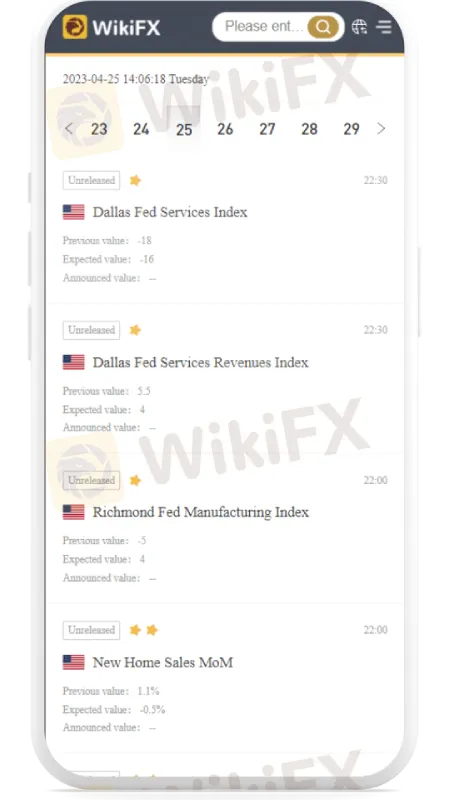简体中文
繁體中文
English
Pусский
日本語
ภาษาไทย
Tiếng Việt
Bahasa Indonesia
Español
हिन्दी
Filippiiniläinen
Français
Deutsch
Português
Türkçe
한국어
العربية
Gold Rises and Dollar Falls: Market Reactions to the Dallas Fed Manufacturing Index Decline
Abstract:The Dallas Fed Manufacturing Index fell more than expected, stoking recession fears and causing the S&P 500 to drop. The US Dollar Index weakened, while gold prices rose. The WikiFX Financial Calendar helps investors stay informed on market developments, allowing them to make well-informed decisions and identify new opportunities.

The Dallas Fed Manufacturing Index report, just issued by the Federal Reserve Bank of Dallas, showed a worse fall than was expected. The indicator declined against the expert estimate of -14.6, dropping from -15.7 in March to -23.4 in April. This fall increases worries about a future recession by showing that the industrial sector is still under pressure.
The research states that “perceptions of the broader business conditions significantly deteriorated in April.” While the new orders index improved, going from -14.6 to -9.6, the production index decreased from 2.5 to 0.9. The future production index, however, fell from 13.5 to 3.0, indicating a minimal increase in output during the next six months.
Treasury rates decreased after the Dallas Fed Manufacturing Index data was released as traders predicted the Federal Reserve would take a more dovish posture to provide more assistance to the economy.
SP500 Drops Amid Fears Of A Recession
Investors focused on the increased possibility of a recession, which caused the S&P 500 to drop from its session highs. The manufacturing sector's difficulties were highlighted further by the Dallas Fed Manufacturing Index's multi-month low.
The U.S. Dollar Index tested its session lows in reaction to the data, and Treasury rates decreased. Forex markets seem to be preparing for a Fed that is less hawkish, which would be negative for the value of the US dollar.
After the report's publication, gold made a comeback and rose over $1,985 once again. The dollar's decline and the drop in Treasury rates both significantly boosted the price of gold.
WikiFX Financial Calendar
For effective trading and investing in today's fast-paced financial environment, being updated about market developments is crucial. Using a financial calendar, like the WikiFX Financial Calendar, is one of the best methods to keep informed. Investors may use this effective tool to track the monetary developments that influence the world markets and make well-informed choices based on current facts.
A complete calendar of financial events, data releases, and economic pronouncements that might affect the direction of financial markets is known as a financial calendar. Investors may anticipate market changes, modify their portfolios, and carefully plan their trading activity by regularly reviewing the WikiFX Financial Calendar.

It is impossible to exaggerate the value of daily financial calendar checks. Numerous variables, such as macroeconomic information, monetary policy choices, and company news, have an impact on the financial markets.
Currency and stock values may be greatly impacted by economic indices like GDP, inflation rates, and unemployment rates. Similarly to this, bond yields and investment flows may be impacted by central banks' interest rate choices. Corporate activities like earnings announcements and mergers may also affect the market's mood.
Keeping up with these market-moving events is possible for investors with a daily check of the WikiFX Financial Calendar. Investors may make wise judgments and steer clear of possible traps by being informed of forthcoming data releases and events. Additionally, keeping up with changes in the world economy might aid investors in spotting fresh investment possibilities and trends.
Download and install the WikiFX App on your smartphone to stay updated on the financial market.
Download the App here: https://social1.onelink.me/QgET/px2b7i8n

Disclaimer:
The views in this article only represent the author's personal views, and do not constitute investment advice on this platform. This platform does not guarantee the accuracy, completeness and timeliness of the information in the article, and will not be liable for any loss caused by the use of or reliance on the information in the article.
Read more

The Hidden Checklist: Five Unconventional Steps to Vet Your Broker
Forex broker scams continue to evolve, employing new tactics to appear credible and mislead unsuspecting traders. Identifying these fraudulent schemes requires vigilance and strategies beyond the usual advice. Here are five effective methods to help traders assess the legitimacy of a forex broker and avoid potential pitfalls.

Doo Financial Obtains Licenses in BVI and Cayman Islands
Doo Financial, a subsidiary of Singapore-based Doo Group, has expanded its regulatory footprint by securing new offshore licenses from the British Virgin Islands Financial Services Commission (BVI FSC) and the Cayman Islands Monetary Authority (CIMA).

CFI’s New Initiative Aims to Promote Transparency in Trading
A new programme has been launched by CFI to address the growing need for transparency and awareness in online trading. Named “Trading Transparency+: Empowering Awareness and Clarity in Trading,” the initiative seeks to combat misinformation and equip individuals with resources to evaluate whether trading aligns with their financial goals and circumstances.

Malaysian-Thai Fraud Syndicate Dismantled, Millions in Losses Reported
The Royal Malaysia Police (PDRM) has received 26 reports concerning the Nicshare and CommonApps investment schemes, both linked to a major fraudulent syndicate led by a Malaysian citizen. The syndicate’s activities came to light following the arrest of its leader by Thai authorities on 16 December.
WikiFX Broker
Latest News
Top 10 Trading Indicators Every Forex Trader Should Know
ASIC Sues Binance Australia Derivatives for Misclassifying Retail Clients
WikiFX Review: Is FxPro Reliable?
Malaysian-Thai Fraud Syndicate Dismantled, Millions in Losses Reported
Trading frauds topped the list of scams in India- Report Reveals
YAMARKETS' Jingle Bells Christmas Offer!
AIMS Broker Review
The Hidden Checklist: Five Unconventional Steps to Vet Your Broker
Revolut Leads UK Neobanks in the Digital Banking Revolution
Fusion Markets: Safe Choice or Scam to Avoid?
Currency Calculator


